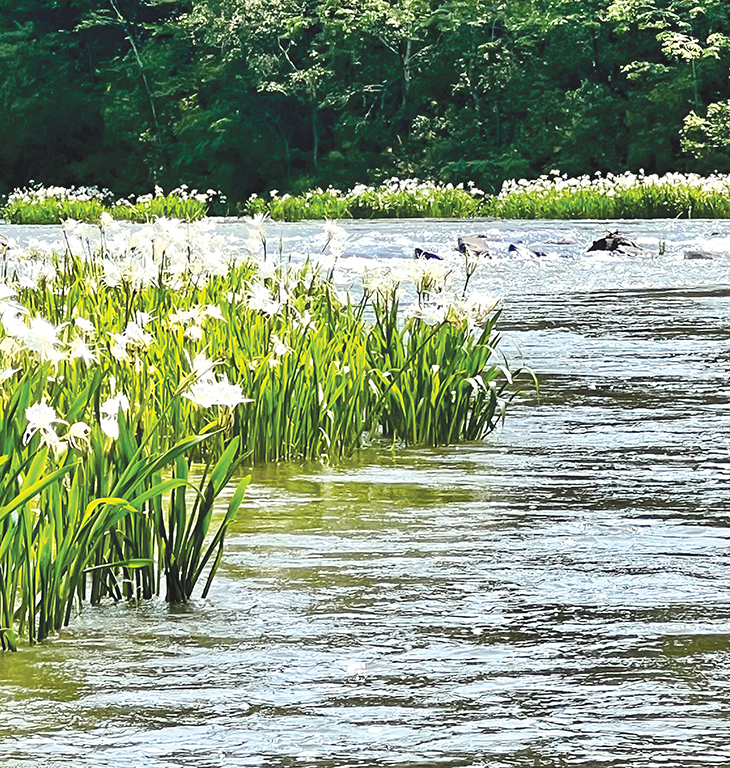CONTRIBUTED BY ACES / BY COLE SIKES
ALABAMA —
Now is the perfect time to visit Alabama’s exquisite river basins. These waterways are teeming with new life thanks to an annual reminder of the state’s beauty, the Cahaba lily. An Alabama Cooperative Extension System aquatic resources expert explains why Alabamians are able to experience these iconic floral features.
WHAT ARE CAHABA LILIES?
Cahaba lillies, known scientifically as Hymenocallis coronaria, are aquatic perennial plants found in sunny, riverine habitats. The species was first described by American botanist William Bartram in 1773.
Also known as the shoal lily or shoal spider lily, is a member of the Amaryllis family. This group is only in four southeastern states. These states include Alabama, Georgia, North Carolina and South Carolina.
“With specific habitat requirements, it should come as no surprise that Cahaba lilies are only found in waterbodies at or above Alabama’s fall line,” said Rachel McGuire, an Alabama Extension aquatic resources outreach coordinator.
AN AQUATIC BIRTH
These lilies begin their lives when their bulbs wedge between rocks and in crevices of shoals along rivers. These areas typically feature swift-flowing water which allows the bulbs to root themselves in their growing sites. In mid April, the lily’s leaves begin to emerge from waterlines followed by flower stalks shortly after.
“The Cahaba lily blooms from middle of May to late June,” McGuire said. “In fact, many locals will be quick to tell you that the lilies bloom between Mother’s Day and Father’s Day. These plants grow up to 3 feet tall and are densely clustered amongst the rocks of the shoals.”
OBSERVATION
The Cahaba lily features dazzling white blooms which can grow to 3 inches wide with six petals, containing one bloom per flowering stalk. Each flowering stalk contains six to nine buds surrounded by bracts, a type of modified leaf.
Individual blooms last only 24 hours, with only one flower bud per stalk opening typically in the evening each day. The flowers are fragrant and contain nectar that attracts a wide variety of insect pollinators. These pollinators include trumpet vine sphinx, plebeian sphinx moth, pipevine swallowtail, blue swallowtail, tiger swallowtail, silver spotted skipper and various bumblebees.
Pollinated flowers mature into a pod that swells and ultimately splits to reveal several oblong green seeds. These seeds become so heavy that they weigh down the flower stalk into the water, where the mature seeds sink. These seeds set up future generations of Cahaba lilies after eventually being deposited into nearby rock crevices by the water’s current.
ROOTED IN COMMUNITY
In Alabama, the most publicly accessible and dense population of Cahaba lilies is found at the Cahaba River National Wildlife Refuge in Bibb County, near the town of West Blocton. This refuge is also home to the annual Cahaba Lily Festival since 1990.
The Cahaba River is not the only river where you can find these aquatic gems. Everyone can also find the Cahaba lily in the Black Warrior, Coosa, Tallapoosa and Chattahoochee river basins. More specifically, the lilies are historically in Hatchet and Yellowleaf creeks and the Mulberry and Locust forks of the Black Warrior River.
POTENTIAL THREATS
There are threats to Cahaba lilies which include river damming, sedimentation and poaching.
“The most likely reason Cahaba lilies have remained prolific in the Cahaba River is its lack of historic damming,” McGuire said. “This has left most of the river free flowing, leaving their critical shoal habitat intact.”
The public has raised awareness and appreciation of the plant in the past decade. The lilies are also under consideration to be protected by the Endangered Species Act.
McGuire said the next time you are driving, especially around the Birmingham area, take a closer look at some of the Alabama license plates. You may find a special tag offered by the Cahaba River Society that features the Cahaba lily.
DON’T WAIT, EXPLORE
Be sure to admire Cahaba lily blooms while they are still vibrant. For more information on Cahaba lilies and where to find them, visit the Alabama Extension website at www.aces.edu.

